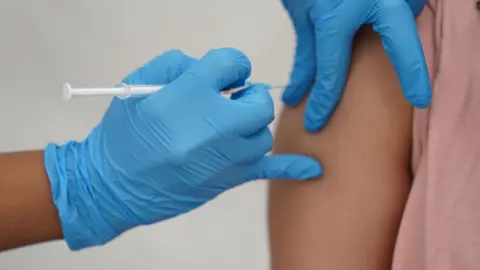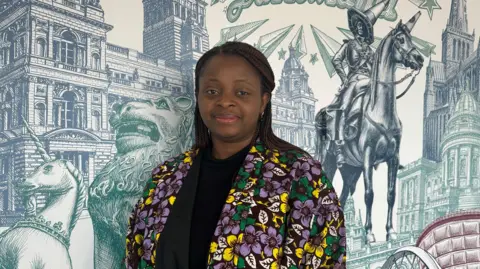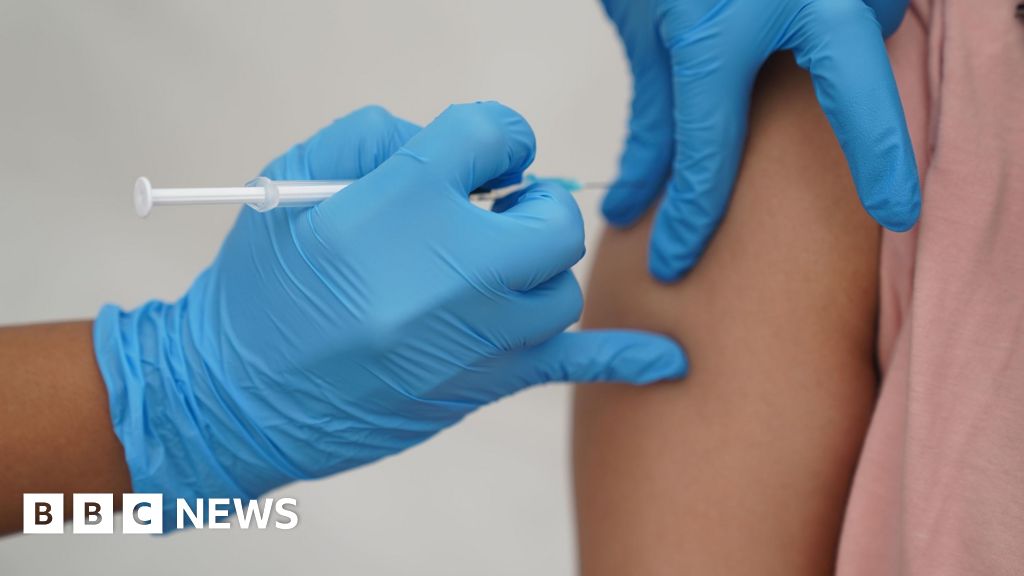 PA Media
PA MediaLast year data on childhood vaccines was broken down by ethnicity for the first time.
It showed a wide variation in uptake across ethnic minority groups and Public Health Scotland called for more work to understand what is going on.
In some areas there is concerns that ethnic minority groups are falling behind the rest of the population when it comes to vaccines.
For instance, the figures showed that almost a quarter of children of African descent in Scotland had not had their second dose of MMR by the age of five.
Uptake was also low for children of Caribbean or Black heritage.
Measles cases have been increasing across Scotland and experts fear children are missing out on full protection against the potentially deadly disease by not getting their second dose.
Lower uptake of vaccines in minority ethnic groups isn’t just seen in childhood immunisations.
Experts say Covid-19, flu and Human Papillomavirus (HPV) show similar trends.
So, why are ethnic minority groups often more hesitant when it comes to vaccination?
What do the stats show?
The BBC has analysed uptake rates across a range of vaccinations and across ethnic groups.
For MMR (Measles, Mumps and Rubella) across Scotland as a whole, the number of children getting the first dose by the age of two is just below the World Health Organisation (WHO) target of 95% to ensure “herd immunity”.
The stats show that not as many children from ethnic minority groups, such as African and Caribbean or Black, are getting the first dose by the age of two but they catch up by the time they are five or six.
However, uptake of the second dose, which provides full coverage against the diseases is concerning health officials.
Only 75% of children in the African ethnic group received the second dose by the age of five last year.
The figure was 83.8% for Caribbean or Black people in Scotland and 87.3% in Asian groups.
The death of a child in Liverpool earlier this month has sparked calls to increase efforts on vaccination.
As part of the strategy, Public Health Scotland has introduced a “status check” and an opportunity to catch up on missed MMR doses in secondary school.
Similarly to MMR, the HPV, Covid-19 and flu vaccine uptake show trends of lower uptake in minority ethnic groups.
Public Health Scotland data for the last flu vaccine programme shows that uptake varies from 55.2% in the White Scottish group, down to 36.2% in the Arab groups, 34.4% in the Pakistani groups and only 22.6% in the Caribbean groups of eligible adults.
Vaccine hesitancy not anti-vax
In June, a health inequalities report from Public Health Scotland studied the factors which had affected the uptake of the Covid and Flu vaccines in some ethnic groups.
It pointed to a lack of trust in organisations promoting the vaccine, not enough information that is culturally and linguistically appropriate, a lack of flexibility in vaccine appointments and perceived harms from vaccines promoted via social media.
Dr Antonia Ho, a professor of infectious diseases at the University of Glasgow, tells the BBC it is important to understand that there were many reasons why people don’t take up vaccinations – it is not simply a case of them being against vaccination.
“Vaccine hesitancy shouldn’t be conflated with being anti-vax,” she says.
Dr Ho says often people who don’t take up vaccines have legitimate concerns.
These could include questions such as whether their ethnic group was represented in clinical trials, she says.
Recent research from the Royal College of Paediatrics and Child Health (RCPCH) also points to other barriers such as the timing and location of vaccine appointments.
It said: “Research and public health resources are sometimes misdirected by focusing too heavily on vaccine hesitancy, when in fact there are many parents who want to vaccinate but simply can’t access services that work for them.”
The report also acknowledges a “growing disparity in vaccine uptake among some ethnic minority groups, socioeconomically disadvantaged families and migrant communities”.
Ethnic minorities treated differently
 Sahira Dar
Sahira DarDr Sahira Dar, a GP in Glasgow and president of the British Islamic Medical Association, says it is important not to assign blame to minority ethnic communities.
“We know that lower vaccine uptake and challenges to access appropriate health services are interlinked,” she says.
Dr Dar says patient experience of healthcare can be more difficult depending on how someone is perceived by healthcare staff.
“If you are black, brown, or from an ethnic minority or if you are a refugee or a woman wearing a hijab, unfortunately patients from these groups are treated differently,” Dr Dar says.
She says there is a correlation between these difficulties in healthcare settings and a general mistrust in the system.
It’s an issue that was highlighted in September last year by Scotland’s Health Secretary Neil Gray.
He acknowledged racism as a “significant public health challenge” and said combatting it was “fundamental” to reducing health inequalities in Scotland.
Cultural barriers to healthcare
According to Dr Dar, a lack of cultural understanding can be a barrier too.
She cites the example of the HPV vaccine, which prevents an infection which is sexually transmitted and is responsible for almost all cases of cervical cancer.
Uptake of the HPV vaccine was reported by ethnicity for the first time in the 2023/2024 school year and it showed the rate was much lower in some ethnic minority groups.
The first opportunity to get the vaccine is in the first year of secondary school when the White Scottish ethnic group had an uptake of 73.7%.
In the same age group, uptake was lower (57.4%) in the Black ethnic group and (53.3%) in the Pakistani ethnic group.
It continues to be administered in school until S4, offering opportunities to catch up on coverage. It can also be available further on the NHS.
In some communities there can be stigma attached to conversations about sexual relationships and sexual health.
Dr Dar says some may view getting the HPV vaccine as encouraging promiscuity.
Dr Sigi Joseph, a GP in Glasgow, echoes this.
“Some cultures might think ‘well my child isn’t going to be having sex’, so they might choose not to get the vaccine,” she says.
Dr Joseph says understanding of different cultural barriers – such as Muslim women who prefer to be treated by another women for modesty – is vital otherwise it could result in people being turned away from accessing healthcare.
“If someone’s had a stressful or difficult experience, they probably would talk to their friends and family,” she says.
“How far that filtrates is difficult to know.”
An overall distrust in ‘the system’

Dr Josephine Adekola, a senior lecturer specialising in disaster risk management at the University of Glasgow, began investigating the reasons for lower vaccine uptake in Scottish African communities in 2021 during the Covid pandemic – and heard a variety of concerns.
“A lot of the hesitancy was linked to discriminatory practices and racism,” Dr Adekola says.
During her study, participants told her about long-running problems, with the immigration sector, schooling, housing, and even insufficient action being taken against workplace discrimination.
“The different experiences of policies interrelate with misinformation and disinformation to create so much distrust in this community to make them hesitant,” she says.
Dr Adekola says that lack of support and bad experiences with one sector can lead to people grouping separate parts of the government and public bodies together, resulting in an overall distrust in “the system”.
Misinformation spreads around the world
Misinformation about vaccines is a widespread problem everywhere.
But Dr Adekola says ethnic minority groups have the extra factor of receiving messages from trusted family members in different countries which contain misinformation or pressure not to get vaccinated.
She says that during the Covid pandemic she heard misinformation such as the suggestion that Black people were immune to the virus.
There was also a conspiracy theory that linked getting the vaccine to the “Mark of the Beast” – a Biblical prophecy which says those that aren’t “marked” will suffer economically, and those that are will be in allegiance with the Antichrist.
It is an issue which was also highlighted by Tory leader Kemi Badenoch who grew up in Nigeria.
Giving evidence at the UK Covid Inquiry in November 2023, she said there were “lots of conspiracy theories” shared in her own family’s WhatsApp group chat and a lack of trust in the government in some communities.
The ‘ethnicity data gap’
Dr Mark Wong, a senior lecturer at the University of Glasgow and expert in ethnicity data, also believes that racism is the key reason for poorer health outcomes for minority ethnic people and why there is a lower vaccine uptake.
He says people from minority ethnic backgrounds are not taken seriously when in healthcare settings.
Dr Wong says they are often dismissed or what they say they are experiencing is not trusted as real.
“That has led to delays in diagnosis, delays in treatment and sometimes, ultimately, early, unnecessary deaths and health problems,” Dr Wong says.
He adds that the mistrust minority ethnic people have towards public authorities and the “heightened alertness” in potentially being discriminated against is not fully understood, which results in public health messaging not effectively reaching or convincing minority ethnic communities.
 Mark Wong
Mark WongDr Wong says proving the link between lower vaccine uptake and higher deaths in ethnic minority communities during the Covid-19 pandemic had been difficult initially because of a long-standing ethnicity data gap in Scotland.
He says there was a “missed opportunity” at the very start of the pandemic to record ethnicity data.
This led to experts in Scotland relying on reporting from the rest of the UK which highlighted the disproportionately negative impact on minority ethnic people.
Dr Wong says he had highlighted this in a working group to the Scottish government at the end of 2020, around the same time as the Covid-19 vaccination rollout began.
However, the recording of ethnicity data only began in November 2021.
He describes having this information documented now as a “turning point” for the quality of ethnicity data for vaccination programmes since then.
In response to the BBC’s questions on vaccine uptake in ethnic minority groups, a Scottish government spokesperson said: “The Scottish Vaccination and Immunisation Programme will continue to focus on increasing uptake of the MMR vaccine, building confidence in communities and reducing health inequalities.
“NHS Boards know their communities best and are responsible for local delivery plans which support accessible and timely vaccination for people who may face barriers to uptake.”
A Public Health Scotland statement said: “Scotland has a very successful vaccination and immunisation programme with high uptake/coverage rates.
“However, as seen in other nations, there have been in declines in uptake over time and persistent health inequalities that leave some communities more vulnerable than others.”

